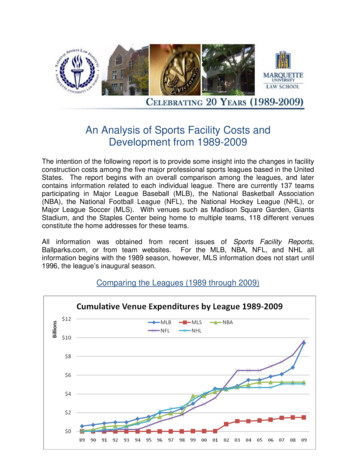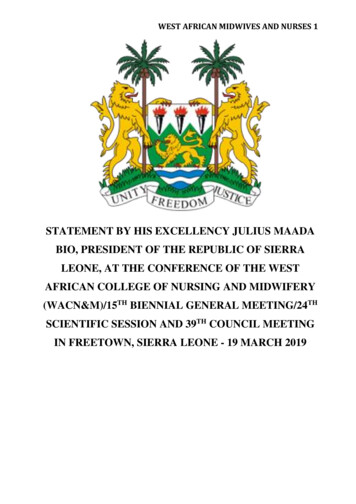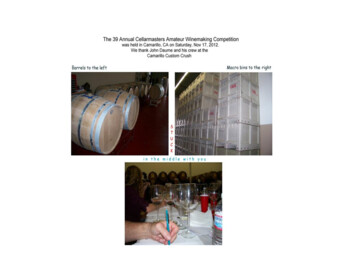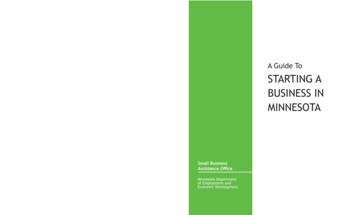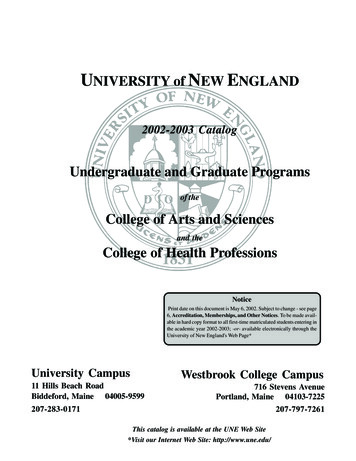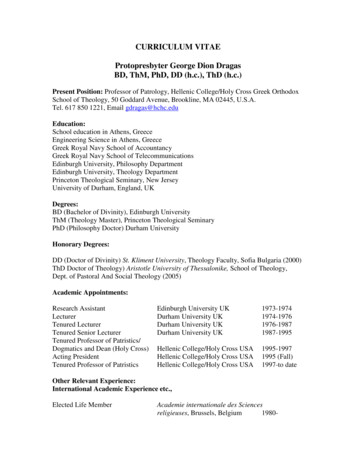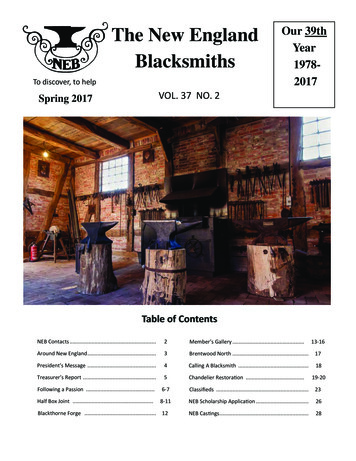
Transcription
The New EnglandBlacksmithsTo discover, to helpOur 39thYear19782017VOL. 37 NO. 2Spring 2017Toby Hickman Spring Meet DemonstratorPhoto by Rory McNamaraTable of ContentsNEB Contacts .2Member’s Gallery .Around New England .3Brentwood North .17President’s Message .4Calling A Blacksmith .18Treasurer’s Report .5Chandelier Restora on .Following a Passion .6‐7Classifieds .23Half Box Joint .8‐11NEB Scholarship Applica on .26Blackthorne Forge .12NEB Cas ngs.2813‐1619‐20
Contact information for NEB officers and directorsJustin Morrell - President (18)207 Greenfield Rd.Colrain, MA. 01340Phone: 413-624-1200artisans@morrellmetalsmiths.comBob Menard - Vice President (18)56 Warren Ave. Suite 106Portland, ME 04103Phone: 207-878-2217ballandchainforge@yahoo.comJim Crothers - Secretary (18)953 Tuckertown RDWakefield, RI 02879Phoneride4782@ride.ri.netLeigh Morrell - Treasurer (18)207 Greenfield RdColrain, MA 01340Phone: 413-624-1200lmorrell205@gmail.comKaren Sims, Membership Chair. (18)337 Rope Ferry RdWaterford, CT 06385Phone: 860-442-3925karensims@gmail.comMartin Custer- NH Rep. (18)77 Tremont St.Exeter, NH 03833Phone: 571-233-0356martin@damage-tech.comTaffy Case - NH Rep. (17)1789 E. Madison RdMadison, NH 03849Phone: 603-367-8225taffysforge@yahoo.comFred Mikkelsen - RI Rep (17)23 Waterman Dr.N. Scituate, RI 02857-2036Phone: 401-647-3086fred@trollshammerforge.comNicholas Downing - ME Rep. (18)22 Orange St Apt 1Portland, ME 04102ndowning@meca.eduJoel Wentworth - ME Rep. (17)618 Overlock Hill RoadUnion, ME 04862Phone: 207-785-4268jgwsr@tidewater.netLynn Lang- VT Rep. (18)405 Browns River Rd.Essex Jct. VT 05452Phone: 802-879-7977langfarm@together.netJudson Yaggy - VT Rep. (17)846 S Rt. 116Bristol, VT 05443Phone 802-453-6005yaggy@gmavt.netBob Phillips - MA Rep. (17)P.O. Box 583Westminster, MA 01473Phone: 978-874-1367happyhovelforge@verizon.netThe ApprenƟce LighƟng the ForgeThanks to allCarl West- MA Rep. (18)PO Box 541372Waltham, MA 02454-1372Phone: 781-608-0900neb@prospecthillforge.comNick Szlosek - CT Rep. (17)Contributors to this issue:Add your name to this listBecome a contributor!Fred MikkelsenLeigh MorrellNicholas Downing3 Barnard DrSimsbury, CT 06070Phone: 701-340-0759szlosekn@gmail.comSteve BronsteinRalph SproulJoel WentworthStephan Connor- CT Rep. (18)141 Old Field LaneMilford, CT 06460Phone: 203-882-0965swconnor@yahoo.comAriane Ferland - RI Rep. (18)PO Box 775Chepachet, RI 02814Phone: 401-568-5971arianeferland@aol.comPhoto CreditsNicholas DowningCharlie SedellJesse SavageRick BarterJudson YaggyWayne ReetzJames MicarelliThe New England Blacksmiths, an affiliate of theArtists-Blacksmith’s Association of North America, isdevoted to the preservation and advancement ofblacksmithing. Letters to the editor, articles, technical tips, tools for sale, or other materials whichfurthers these ends, will be considered for publication in this newsletter.Spring 2017Note: The number ( ) after each name denotes theyear of term expiration of that Board Member.The New England Blacksmiths disclaim any responsibility or liability for damages or injuries as a result ofany design, construction, manufacture, use or otheractivity undertaken as a result of the use or application of information contained in the newsletter of theNew England Blacksmiths.Page 2Lisa TutinasRalph SproulJoel WentworthNext newsletter deadline:June 15th, 2017New England Blacksmiths
Around New EnglandBrentwood Teaching CenterNew HampshireOpen forge season has started at the BrentwoodTeaching Center in Brentwood, NH. The forgewill be open to all comers the last Saturday of themonth through November. Come visit for a day ofSmithing. For more information email BobMenard ballandchainforge@yahoo.comMassachusetts1st weekend in August, Hancock Shaker Village,(Pittsfield, MA) will host their annual Age of Iron.www,hancockshakervillage.orgMaineNew England School of Metalwork classeswww.newenglandschoolofmetalwork.comBeginner Blacksmithing April 25-28ABS intro to Blade Smithing May 1-12Introduction to Blacksmithing May 15-26Beginning Blacksmithing May 15-19Intermediate Blacksmithing May 22-26Beginner Blade Smithing May 30 –June 2Traditional Joinery June 5-9Blacksmith Folding Knife June 13-15Multi-bar Viking Seax June 19-23Fine Forged Bench Tools June 26-30Fireplace Tool Set July 6-9ABS Hammer In July 14-16Forged Fighting knife July 18-22Beginning Blacksmithing July 25-28English Latch July 31-Aug 4Lock back Folder August 7-13Something from Nothing August 15-17ABS intro to Blade Smithing Aug. 21-Sept. 1Connecticut http://www.zagrayfarmmuseum.org/ 544 Amston Road (Rt. 85), Colchester, CTQuinebaug Valley Engineers Association Inc.(QVEA)Spring Show May 6 & 7, 2017 ml - yes, their URL date text is off,but this is correct for 2017The Connecticut Antique Machinery Assoc.Spring Power-up and Open House May 6, 2017Vermont7th Annual HammerIn at the LCMM (at the BasinHarbor Club) Vergennes, VT is: May 13, 2017,9am - 4pmFeatured Blacksmith: Robert Bordeaux who willshow the steps in forging a knife.Rhode IslandJoin the Southern Bunch at South County Museum in Narragansett, RI on the 4th Saturday of theMonth. Contact Jim Crothers 401-783-5400 orjim@southcountymuseum.org for more information.Spring 2017Off the West Coast of New EnglandAdirondack Folk School, Lake Luzern, NYwww.adirondackfolkschool.orgMay 6 & 7 Forge a Chef’s KnifeMay 13 Forged Marshmallow ToasterMay 19-22 Basic Blacksmithing Level 2June 10-11 Intro to Tool MakingJune 17 Create a Triangular Dinner BellJune 19-21 Basic Blacksmithing for WomenJune 28-July 1 Intro to BlacksmithingJuly 8-10 Forged Camp Ax.July 14-16 Mokume GaneJuly23-24 Forge WeldingJuly 28-30 Intro to Blade SmithingAugust 3-7 Bowie KnifeAugust 12-13 Finials and TwistsAugust 14-18 Intermediate BlacksmithingAugust 21-25 Mastering the Fundamentals of SmithingAugust 25-27 Hammer MakingSeptember 14-18 Blacksmith’s Third HandPage 3New England Blacksmiths
President’s Message for January 2016:Hello my Friends and fellow Blacksmiths,I had great plans bouncing around in my head for this president’s note. I was going totalk about what was going on in our community and how great things are .But my heart is heavy. For those of you that haven’t heard, Steve Bronstein of Black‐thorn Forge lost his shop to a massive fire while he was away on vaca on. Then, on the23rd of April, Jonathan Nedbor of Canal forge lost his house and old shop to a fire. Ihave nothing fun to say. I will say that this is the me that we as a community need topull together and help our friends out. There is a GoFundMe campaign for both ofthese smiths. I know these aren’t easy mes for any of us, but please help out ourfriends and fellow smiths in any way that you can.Thank you for your friendship and your support,Jus nh an‐nedborh eThe Blacksmith’s DilemmaMany New England farmsteads included small blacksmith shops to provide extra income. The Winsor shop inFoster, RI is an example of that. Jonas had 4 sons and wished to divide his 100 acres and yet retain 25 forhimself and their mother. He needed to keep the homestead, barns and blacksmith shop on the 25 he wouldkeep for himself. How might he equally divide the remaining 75 amongst the 4 boys?Answer on another pageSpring 2017Page 4New England Blacksmiths
Editor’s Note;Steve Bronstein, a long me member from Vermont, experienced a catastrophic firethat consumed his shop. Apparently it was quite the show for the local volunteerfire departments as it was fully involved on their arrival. No one was injured andthere was no damage to his house. The business was insured but as is o en revealeda er a significant loss there was a gap between the coverage and the real world ofre‐equipping a business. The following is from Steve to the membership.I am thinking about how I want to rebuild. My budget will probably require a metal building,Your EditorsMy old shop had a tamped crushed shale floor that I liked. It was smooth, easy to find lostBob & Debby Menardbolts, warm and the drain was everywhere. It was also dirty and hard to roll heavy objects. Itwas rare that we moved things so when I moved in my Fairbanks 20 years ago I set downplanks and used rollers. I haven’t moved it since so this might not be an issue. I am considering only pouring a half concrete floorand leaving it stone around the forge area. The next owner could finish the pour if they wanted.I will need to rebuild my Fairbanks 100# and Bull Classic. Any advice would be appreciated.I have insurance money to spend on tools so I need:Horizontal BandsawDrill PressBelt Grinder 1 x 42" and/or 2 x 72"Vibratory TumblerArc WelderRight Angle GrindersBarrel Tumbler6” Bench Grinder2 Mig WeldersOxy/Acetyl SetupTwo 5hp Compressors or one 7.5 hp CompressorTIG TorchIndustrial ShelvingI have a reasonable budget to buy some of this new but would like to stretch my dollars as far as I can.Any thoughts or suggestions would be appreciated.Best regards,Steven BronsteinBlackthorne ForgeSteve has set up a go fund me site to help with un-insured costs.Marshfield, Vermonth ewww.blackthorneforge.com802-522-3274Treasurer’s Report by Leigh MorrellCurrent assets; Checking and savings account balancesCas ng inventoryClothing inventoryFixed assets; Brentwood Teaching CenterBlacksmith’s TotemTeaching Center & EquipmentGreen Coal trailer and contentsOther current assetsTotal assets; 29,367.64 8263.00 562.85 19,056.00 6750.58 18,434.23 3810.96 14,617.09 96,862.35Current Liabili es; 645.00This report was summarized and edited for space. If any member would like a more complete breakdown of ourgroup’s finances they can contact Leigh directly for more informa on.Spring 2017Page 5New England Blacksmiths
Following a PassionThis was reprinted from the Hannaway House NewsleƩerShane Milano has wanted to be a blacksmith for as longback as he can remember. He got the dream of a lifetime whenhis dad, Tom, discovered the Hannaway Blacksmith Shop as aplace where Shane could pick up a hammer and begin to learnthe traditional craft of hand forging. It didn't phase Tom thatthey lived in New York and the Hannaway Shop was in RhodeIsland. It was about giving his son the opportunity to learnabout something he was passionately interested in.For the past two years, Shane has been coming to theHannaway Shop once a month for a four-hour class on a Saturday morning. I met up with Shane duringone of his lessons recently to talk about his experience. Despite the fact that there was a snowstorm in progress, it did not deter Shane and his dad from making the trip from Long Island. They left their home at 4a.m. to make it to Shane's class by 8 a.m. and arrived home at 7 p.m., after driving through white-out conditions and catching the last ferry out of New London. Talk about commitment!Q. Tell us a liƩle about yourself.A. I am a first year student college student at Farmingdale State College on Long Island. I started takingblacksmithing class in January 2015.Q. What got you interested in blacksmithing?A. I have always aspired to be a blacksmith and would go online to watch videos to learn how it was done.Then there were TV shows like "Game of Thrones" and "Forged in Fire" that I got interested in. I reallywanted to take lessons and my dad found the Hannaway Shop. He had searched everywhere but this wasexactly what we were looking for. It just happened to be 200 miles away.Q. Why do you travel so far to take class?Tom answers: I would travel as far as necessary for something my son enjoyed. It is a long day for us but itis worth it. He is excited about each and every class he takes. Shane adds: I can't sleep the night before,just thinking about the project I will work on the next day.Q. What is your favorite part about your experience at the Hannaway Shop?A. My favorite part is of course learning how to make something, but I enjoy my time talking with my in-structor, Ed, just as much. He is great!Q. What have you made?I really like to make knives because I collect them. My first knife was one I made from a railroad spike. I enjoy creating intricate designs on the handle. I've also made a candleholder for my mother.Q. How long do you think you'll take class?A. A very long time!!Q. What do your friends think about your hobby?A. My friends think it's awesome! I've even brought some of my friends here to take class with me just togive it a try. They really liked it too.Q. Why should young people care about this old craŌ?A. It is an art and history that we should keep alive. Blacksmithing has been so impactful throughout ourhistory and people don't even realize how important it was. The blacksmith made everything for us.Q. What are your ambiƟons?A. I want to be a world-renowned blacksmith. If I can't achieve that, then I'll always do this as a hobby.Spring 2017Page 6New England Blacksmiths
Following a Passion, con nued;Q. Anything else you want people to know?A. Tom answers: I am fascinated with the level of commitment and patienceShane has shown for this. It is really rare for someone his age to have that.This one day a month is quality father-son time to treasure. There is norush, we have four hours each way driving here and back to talk. He's enjoying his class and is learning a lot. I like history so while he's in class, I'mexploring Great Road and other places around Lincoln. Classes in handforging are offered every weekend year round at the Hannaway Shop.Visit our website to learn more about the Hannaway Shop and tosign up for classes send an email to info@hearthsidehouse.orgSpring 2017Page 7New England Blacksmiths
The Half Box Joint by Nicholas DowningLast year I applied for and received a scholarship from NEB to attend a classcalled ‘Traditional Hearth Tools’ at the New England School of Metalwork. Theclass was taught by Jay Close and focused on two implements: fire tongs and anash shovel. These tools are what would have been used extensively in colonialtimes, and you can still find them in old homes and at antique stores andmuseums around New England.I will spare you the details about how hot it was that week, and how bad thetraffic was between Southern and Central Maine, etcetera, etcetera. I do,however, wish to mention three things before I get down to what we actuallyaccomplished in the class. First, I’d like give a quick shout out to NESM. All oneneed do is stand in the common area and slowly turn 360 to see more top notchironwork than you can shake a hammer at. Second, Jay Close is an exceptionalteacher. In addition to his demos, he gave us a well-drawn and concise handoutdetailing what we were about to undertake. Third, I will say that applying for thescholarship through NEB was simple. If you want to take a class but find it a littleout of reach financially I strongly encourage you to apply.There is really only one aspect of the hearth tool’s construction I would like to detail in this article, because it isparticularly unique and challenging: the ‘half box joint’ of the fire tongs. For those not familiar, colonial fire tongs arevery different from the type of tongs you might use as a blacksmith. They really function more like a large pair oftweezers, but rather than being spring actuated they have a sort of mortice and tenon construction. The real challengeof this type of joint is to make it crisp so that the tongs work smoothly while also, when the joint is closed, fit up tightlywith no unsightly gaps. To date, I have made three pairs of this type of fire tong, and I’d say I only really nailed itonce.In the class, we started with two pieces of ¾” square bar. The handle and female side of the tongs are made from 9”and the male side is made from 6 ½”. The first operation was to centerpunch mark several spots along the longer bar. The first is 2” from one end,the second 1½” below that, a third 2 ½” below that which leaves 3” on theother end. We started by necking-in in both dimensions within the 2”measurement eyeballing ¾” cube of material that would later become a finialend. We then used half faced blows at the third center punch mark down (31/2” from the original length) to knock the material down to roughly half itsoriginal width, and forged in the resulting swell to restore the originaldimension. Be generous here- it is tempting to over-forge this section andmake it too thin. If the original dimension of the bar is 3/4”, you’re better offStarƟng Materialhaving it a 9/16” or even 5/8” than 7/16”.DeviaƟng FinialSpring 2017First ShoulderingPage 8New England Blacksmiths
The Half Box Joint, continuedThis demarcates the bottom of the female side of the half box joint. With the profile of the handle andfemale side of the joint roughed in it is time to make the mortice. To do so you will need a slitting chisel- wemade ours from ½” square W-1 and a drift. We used 1 ¼ x 1/4” mild with a long taper at the business endand a short taper at the struck end. With the shoulder turned upwards mark the center of the bar at the topof the transition. The project requires an offset (diagonal) slot to accept the male side of the joint properly.Use the slitting chisel at a 45 angle tilting it into the shoulder you’vecreated. Be careful not to let the chisel drift below the shoulder.This is easier said than done, as the thinner material offers a path oflesser resistance. Once you’ve cut ¾ of the way through, flip the barover and offset the chisel towards the finial, by half the length of itsedge and cut the remainder of the way through.To drift the hole, insert the narrow end of your drift and tap it intoplace. Use the edge of the anvil or vice jaws to support the workwhile driving the drift. Most of the drifting should be done from thesides (i.e. form the slot the same way you would forge the cheeks ona hammer or hatchet). Switch to the cross peen periodically toexpand the material on the drift. It will probably take several heatsand you should alternate the side the drift is inserted from as it slowlyFirst Profilestretches up to size. Ilearned it was best notto cool the drift between heats as itwill act as a heat sinkand cool the thin material on either sides of the slot too quickly.Be advised the hot drift presents a risk to unthinking fingers andthe soles of shoes. Keep a pair of pliers handy and leave thedrift on the step of the anvil between heats.With the female side of the joint formed, it is time to switch tothe other section of bar, center punch at 1” from the end of thisbar and again 2&½” below that. Hang the end of the bar overthe edge of the anvil at the first mark and shoulder in with halffaced blows to a little over half the parent bar dimension. Do notforge in the resulting swell this time. Now, with a SmithingToolingMagician, a spring fuller, an assistant with a set hammer, or carefullywith the edges of the anvil, forge down the, untouched material above the shoulder create a double shouldera little wider than the corresponding slot in the female side of the joint. This should be done at an angle thatwill match the shouldering of the slotted side of the joint, You can now use a leg vice to upset theshoulders above the bit. It is a little awkward because you’ll want to do this at an angle. This is also whyyou do not forge in the spread from the first shouldering operation, the mass helps mitigate any bending ofthe thinner material.SliƫngCenteringSpring 2017Page 9New England Blacksmiths
The Half Box Joint, continuedYou will probably have to straighten the bar a few times, and it maytake 3 or more heats to upset the double shoulder above the bit tothe parent bar dimension or even, ideally, a little wider. With themale bit roughed out you may now forge in the swelling from thefirst shouldering operation, and shoulder in at the second centerpunch mark. Flatten the remaining material between the shouldersto roughly ½ parent bar dimension and forge in the swelling . Nowis also when the male end is held up to the female side of the slotand marked where it needs to be trimmed. This is done with ahacksaw and files.DriŌingWhen the two sides look as though they should fit together, reheatthe female side of the joint and drive the (now cool) male side intothe slot. You may have to put a subtle bend in one or both pieces so that the parent material at each enddoesn’t get in the way. A pillow block or other anvil tool in the hardy hole can be helpful to back the femaleside against while inserting the bit.With the bit driven home, reheat both pieces together in the forge andhammer them on the sides and top. If you’ve done a good job the bitshould fit the slot tightly and the joint, when viewed from the front andback, should fit up well with minimal gaps and be approximately theoriginal ¾” dimension.The joint is now done, excepting theflush rivet that holds them together(which should be done last). It is nowtime to form the upset corners at theStarƟng the Male Endtop of the bows. This comes with itsown challenges. On the bright side, thesecond shoulder, which is formed while the bows are still straight, falls intoplace nicely as the shouldered material forms the second upset.The BitUpseƫng ShouldersSpring 2017Roughed InPage 10Ready to FitNew England Blacksmiths
The Half Box Joint, continuedOnce the second upset is complete, the bows arebent around putting the stubs of the bar back in line,though slightly offset with the joint and handle. Thestubs are scarfed and ½” square or round bar isforge-welded on which is made into the arms andpads of the tongs. It is a difficult project but veryrewarding and didactic when executed well. Goodluck!The Money ShotThe Finished PartsThe Assembled JointThe Blacksmith’s Pub is a new smithing oriented podcast created andhosted by two of our own, Jesse Savage and Rick Barter. It is a free for allconversa on between Rick, Jesse, and their guest(s).Subjects range from shops and fly presses to pa ern weld steel. At mesit is a bit of a roller coaster ride through the main topic with a li le sidetracking thrown in for good measure. Give them a listen and see what thelatest buzz is about.www.theblacksmithspub.comSpring 2017Page 11New England Blacksmiths
Some observa ons on the true cost of InsuranceInsurance is not something we think about very often, and if we do it is to complain about how expensive itis. I now have a different attitude towards insurance.On March 28, my shop was destroyed by a fire. Luckily, I was insured, unfortunately, not for enough. Ithought I had done a good job assessing my risk and exposure to a catastrophe. I had made a critical errorin my judgment.My shop was located in a 150 year old dairy barn. Some described it as with a lot of character, less kindly itwas ratty old barn, that was only standing because of habit. However, it was a great place for my businessand it is where I made my living for the last 18 years. After the fire, I was relieved to confirm that I had insurance. There was a dollar amount limit for the building and also for the contents. At the time that I determined these numbers I thought I was making a more than reasonable assessment. This is where I made mymistake.This old barn, which added no value to the assessed value of my property, was not going to be replaced byanother old, ratty barn. It has to now be replaced with a new, modern, and up to code commercial structure.To build this building it will cost closer to 50% more than I have coming from insurance. In my thinking aboutrebuilding, I imagined some time in the future when I might be done with blacksmithing and replacing thebarn with a two car garage. The fire came 3 months after I had renewed my policy. The time is today for meto be dealing with this and the reality is far different than what I had ever considered.The second issue is the contents of my building, my tools and equipment. I was covered for what I considered a lot of money, but it turns out it is not enough to replace what was lost. Here are two examples.I had an old, used, Kalamazoo band saw that I bought for 1200. I decided that to replace it might cost asmuch as 2000 so that is what I used when I was compiling my potential loss. What I did not consider wasthat I had spent 5 years waiting for this good deal to present itself. I need to buy one today and I may not beable to find such a good deal. Again, remember, if I want to get back to work I have to buy everything today,so I may end up buying a new one for closer to 4000, twice what I had budgeted.A second example is a CNC Plasma Table that is crucial to my business. I bought this, 2 years ago, for 7500. I called the company last week and that machine is now 20,000. It turns out, I got such a goodprice on the original machine because they were about to discontinue the line and were switching over tothe more expensive system. Again, I did not plan for this contingency.The lesson is that I needed to think much harder about what I had and what it would take to replace it. Thisis challenging and requires a lot of research.I now consider all of the money that I have spent on insurance a really good investment. It is very hard toimagine your needs before a crisis and that is exactly what I will be doing when I renew my policy.One thing I forgot to mention, I had 35 years of shop notes. About 15 years ago I had scanned some ofthem. I have not done it again since so I am missing and having to recreate all of the little notes to myselfabout how I make my current product line. Note to self, it is easier to backup then to remember what youdon’t know you have forgotten.Steven BronsteinBlackthorne ForgeMarshfield, VT 05658steve@blackthorneforge.comSpring 2017Page 12New England Blacksmiths
MEMBERS’ GALLERYCharlie SedellSpring 2017Page 13New England Blacksmiths
MEMBERS’ GALLERYJesse SavageRick BarterSpring 2017Page 14New England Blacksmiths
MEMBERS’ GALLERYJudson YaggyWayne ReetzSpring 2017Page 15New England Blacksmiths
MEMBERS’ GALLERYJames “Mic” MicarelliSpring 2017Page 16New England Blacksmiths
Brentwood NorthBrentwood North enjoyed its 14th consecu ve gathering on March 4th. Once againwe had a sell out crowd and if I consider instructors and visitors, at the high pointthere were 20 people in the shop.This year’s instructor line up included Kyle Connolly featuring an element focusing onlaying out a flat bar, forging in a detail, and thenbending into an infinity shape and having the forging align appropriately. NicholasDowning was doing a Thor’s Hammer pendant. Bob LaVoie hosted an arc weldingsta on that assembled pre‐made parts into a smithing magician that fit a hardy hole.Joel Tripp was the final instructor. His project was a soup spoon forged from a pieceof 1/4”x 1 flat bar 2 1/2” long.The students age‐range spanned early teens toearly 70s with everything in between. Some were returning guests from previousevents where others experienced it for the first me. There was an air of enthusiasmas the day started. With the excep on of Joel, the other instructors were returningalumni, so they had a good grasp of the challenges of keep the subject within the 90minute me frame. Everyone rose to the challenge and right from the start theprograms were all completed in the allo ed me.Lunch was a Brentwood North staple and crowd favorite, firehouse chili. Appe tes were sharpened by the morning’sforging and considerable damage was done to the 4 gallons of chili andassociated fixings of corn bread, rolls, cider, and brownies.A er lunch there was conversa on and show and tell of some items folksbrought along with them. There were some fascina ng items showcased bystudents and instructors alike.The a ernoon sessions ran even smoother than the morning’s and we finishedup on me. Some of the folks that had the furthest to travel headed right out while some others stayed on for moregabbing. As is appropriate I was first in at 4 am and last out at 6 pm but I le with a sa sfied feeling. It was a robustblacksmithing day enjoyed by all.I would like to extend my thanks to all the par cipants. They all combined efforts to make this event a rousingsuccess.Bob MenardSpring 2017Page 17New England Blacksmiths
When calling a Blacksmith is the only op onSanborn Mills Farm had a dilemma. Their millwright, Brian Clough, neededto be able to li the 1000 lb. grinding stone in the grist mill and flip it overfor dressing and sharpening. Due to the ethic promoted by the farm having abright red engine hoist or similar apparatus was a no go. This is where RalphSproul enters the story. Working collabora vely Brian, Ralph created a tongtype assembly and a mber frame jib crane to become a fixture in the gristmill and facilitate this cumbersome opera on .Mill stone craneA busy jig to aid in consistencyMatched armsFirst driŌ on the pass throughTong spanner bar with slide handleSpring 2017Page 18New England Blacksmiths
Chandelier Restora on for Land Trust RebuildCoastal Mountains Land Trust of Camden Maine has been engaged in an ongoing restora on of property at theBeech Hill Preserve. Part of this restora on is a 100 year old sod roofed stone hut built in 1914 by aNorwegian landscape architect Hans O. Heistad. Thisbuilding was resurrected from a ruin in 20
Ralph Sproul Joel Wentworth Next newsletter deadline: . show the steps in forging a knife. Rhode Island Join the Southern Bunch at South County Muse-um in Narragansett, . thorn Forge lost his shop to a massive fire while he was away on vaca on.Then, on the 23rd of April, Jonathan Nedbo



